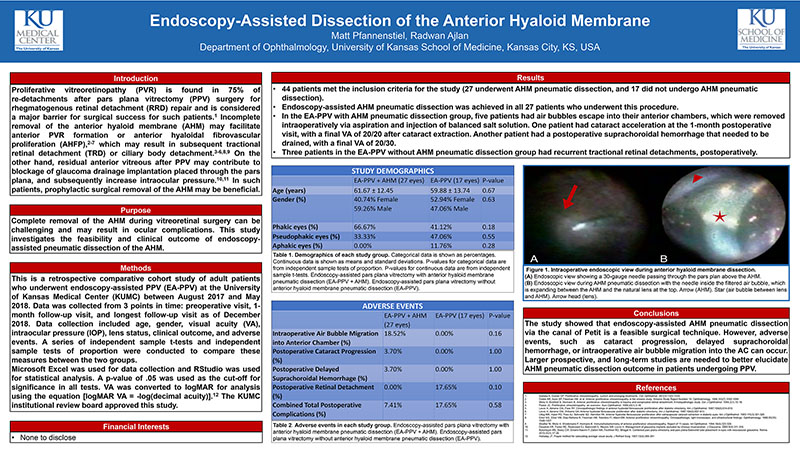
Hover to pan and click to magnify. Click again to pan at full screen.
Matt Pfannenstiel, BS. Radwan Ajlan, MBBCh.
Matt Pfannenstiel, BS. Radwan Ajlan, MBBCh.
University of Kansas School of Medicine
Introduction
Proliferative vitreoretinopathy (PVR) is found in 75% of re-detachments after pars plana vitrectomy (PPV) surgery for rhegmatogenous retinal detachment (RRD) repair and is considered a major barrier for surgical success for such patients.1 Incomplete removal of the anterior hyaloid membrane (AHM) may facilitate anterior PVR formation or anterior hyaloidal fibrovascular proliferation (AHFP),2-7 which may result in subsequent tractional retinal detachment (TRD) or ciliary body detachment.3-6,8,9 On the other hand, residual anterior vitreous after PPV may contribute to blockage of glaucoma drainage implantation placed through the pars plana, and subsequently increase intraocular pressure.10,11 In such patients, prophylactic surgical removal of the AHM may be beneficial.
Purpose
Complete removal of the AHM during vitreoretinal surgery can be challenging and may result in ocular complications. This study investigates the feasibility and clinical outcome of endoscopy-assisted pneumatic dissection of the AHM.
Results
• 44 patients met the inclusion criteria for the study (27 underwent AHM pneumatic dissection, and 17 did not undergo AHM pneumatic dissection).
• Endoscopy-assisted AHM pneumatic dissection was achieved in all 27 patients who underwent this procedure.
• In the EA-PPV with AHM pneumatic dissection group, five patients had air bubbles escape into their anterior chambers, which were removed intraoperatively via aspiration and injection of balanced salt solution. One patient had cataract acceleration at the 1-month postoperative visit, with a final VA of 20/20 after cataract extraction. Another patient had a postoperative suprachoroidal hemorrhage that needed to be drained, with a final VA of 20/30.
• Three patients in the EA-PPV without AHM pneumatic dissection group had recurrent tractional retinal detachments, postoperatively.
STUDY DEMOGRAPHICS
(View poster)
Table 1. Demographics of each study group. Categorical data is shown as percentages. Continuous data is shown as means and standard deviations. P-values for categorical data are from independent sample tests of proportion. P-values for continuous data are from independent sample t-tests. Endoscopy-assisted pars plana vitrectomy with anterior hyaloid membrane pneumatic dissection (EA-PPV + AHM). Endoscopy-assisted pars plana vitrectomy without anterior hyaloid membrane pneumatic dissection (EA-PPV).
ADVERSE EVENTS
(View poster)
Table 2. Adverse events in each study group. Endoscopy-assisted pars plana vitrectomy with anterior hyaloid membrane pneumatic dissection (EA-PPV + AHM). Endoscopy-assisted pars plana vitrectomy without anterior hyaloid membrane pneumatic dissection (EA-PPV).
Figure 1. Intraoperative endoscopic view during anterior hyaloid membrane dissection.
(A) Endoscopic view showing a 30-gauge needle passing through the pars plan above the AHM.
(B) Endoscopic view during AHM pneumatic dissection with the needle inside the filtered air bubble, which is expanding between the AHM and the natural lens at the top. Arrow (AHM). Star (air bubble between lens and AHM). Arrow head (lens).
(View poster)
Conclusions
The study showed that endoscopy-assisted AHM pneumatic dissection via the canal of Petit is a feasible surgical technique. However, adverse events, such as cataract progression, delayed suprachoroidal hemorrhage, or intraoperative air bubble migration into the AC can occur. Larger prospective, and long-term studies are needed to better elucidate AHM pneumatic dissection outcome in patients undergoing PPV.
References
1. Sadaka A, Giuliari GP. Proliferative vitreoretinopathy: current and emerging treatments. Clin Ophthalmol. 2012;6:1325-1333.
2. Diddie KR, Azen SP, Freeman HM, et al. Anterior proliferative vitreoretinopathy in the silicone study. Silicone Study Report Number 10. Ophthalmology. 1996;103(7):1092-1099.
3. Mietz H, Kirchhof B, Heimann K. Anterior proliferative vitreoretinopathy in trauma and complicated retinal detachment. A histopathologic study. Ger J Ophthalmol. 1994;3(1):15-18.
4. Pastor JC. Proliferative vitreoretinopathy: an overview. Surv Ophthalmol. 1998;43(1):3-18.
5. Lewis H, Abrams GW, Foos RY. Clinicopathologic findings in anterior hyaloidal fibrovascular proliferation after diabetic vitrectomy. Am J Ophthalmol. 1987;104(6):614-618.
6. Lewis H, Abrams GW, Williams GA. Anterior hyaloidal fibrovascular proliferation after diabetic vitrectomy. Am J Ophthalmol. 1987;104(6):607-613.
7. Ulbig MR, Hykin PG, Foss AJ, Schwartz SD, Hamilton PA. Anterior hyaloidal fibrovascular proliferation after extracapsular cataract extraction in diabetic eyes. Am J Ophthalmol. 1993;115(3):321-326.
8. Elner SG, Elner VM, Diaz-Rohena R, Freeman HM, Tolentino FI, Albert DM. Anterior proliferative vitreoretinopathy. Clinicopathologic, light microscopic, and ultrastructural findings. Ophthalmology. 1988;95(10): 1349-1357.
9. Stodtler M, Mietz H, Wiedemann P, Heimann K. Immunohistochemistry of anterior proliferative vitreoretinopathy. Report of 11 cases. Int Ophthalmol. 1994;18(6):323-328.
10. Desatnik HR, Foster RE, Rockwood EJ, Baerveldt G, Meyers SM, Lewis H. Management of glaucoma implants occluded by vitreous incarceration. J Glaucoma. 2000;9(4):311-316.
11. Kolomeyer AM, Seery CW, Emami-Naeimi P, Zarbin MA, Fechtner RD, Bhagat N. Combined pars plana vitrectomy and pars plana Baerveldt tube placement in eyes with neovascular glaucoma. Retina.
2015;35(1):17-28.
12. Holladay JT. Proper method for calculating average visual acuity. J Refract Surg. 1997;13(4):388-391
Financial Interests
None to disclose

Present with Google Meet
Invite as many as 30 people, and present your poster in high definition. Transcription option is available. Free to use.
DISQUS COMMENTS WILL BE SHOWN ONLY WHEN YOUR SITE IS ONLINE